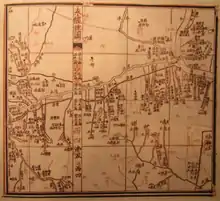Commentary on the Water Classic
The Commentary on the Water Classic (Chinese: 水经注), or Commentaries on the Water Classic, [1] commonly known as Shui Jing Zhu, is a work on the Chinese geography in ancient times,[2] describing the traditional understanding of its waterways and ancient canals, compiled by Li Daoyuan during the Northern Wei Dynasty (386-534 AD). The book is divided into sections by river, each described with its source, course, and major tributaries, including cultural and historical notes.
| Commentary on the Water Classic | |||||||||
|---|---|---|---|---|---|---|---|---|---|
 A map of the Wei River from Shui Jing Zhu | |||||||||
| Traditional Chinese | 水經注 | ||||||||
| Simplified Chinese | 水经注 | ||||||||
| |||||||||
The work is much expanded from its source text, the older (and now lost) Water Classic (Shuijing 水經). The original text described 137 different rivers in China and was traditionally credited to Eastern Han scholar and geographer Sang Qin (桑钦) during the Three Kingdoms Period (220-280 AD). [3] Qing dynasty scholars gave it a later date (during the Three Kingdoms Period) because of the names of the counties and commanderies. Its authorship was then attributed to Jin dynasty scholar Guo Pu. Li Daoyuan's 40-volume, 300,000-character version includes 1252 rivers.
Although very thorough for its time, it did repeat the earlier mistake of the "Tribute of Yu" in viewing the Min as the headwaters of the Yangtze. It was not until the Ming dynasty that Xu Xiake correctly listed the Jinsha as the principal source.
See also
- Yang Shoujing and Xiong Huizhen, authors of the 19th-century annotation Shui Jing Zhu Shu (水經註疏)
References
- Ying-shih Yü (20 September 2016). Chinese History and Culture: Sixth Century B.C.E. to Seventeenth Century, Volume 1. Columbia University Press. pp. 127–. ISBN 978-0-231-54201-2.
- Ji Lu. Biography of Li Daoyuan. DeepLogic. GGKEY:PS5B7KYN5KH.
- "Commentary on the Waterways Classic - Geographer's ideas flow like a fresh spring". Shanghai Daily. September 2, 2012.
Further reading
External links
| Chinese Wikisource has original text related to this article: |
- "Chinese Literature: Shuijingzhu 水經注 "Commentary to the River Classic" " at China Knowledge
- "Unter dem Himmel" (in German)
